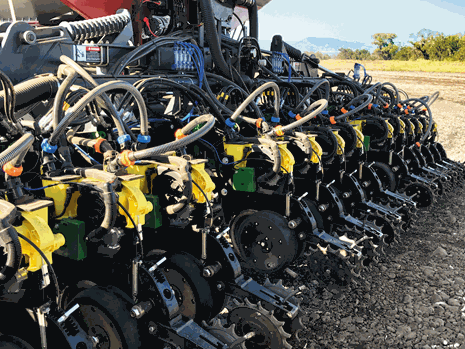Precision planting technology
Farm Trader takes a look at data collection and precision planting technology
Every paddock has its good and bad patches that farmers try to bring together, but what if you could cater to their separate strengths? Andrew Hobbs speaks with New South Wales farmer David McGavin, who says he’s found a way.
 |
|
The SmartFirmer system, produced by US company Precision Planting
|
Farming a 400-hectare family property in Liverpool Plains (north central New South Wales), David McGavin says he has had the good luck to be working in a good farming area despite the weather patterns of the past few years.
"Summer crops grow well there because they generally have cooler nights, so the plant can recover. There’s not a lot of barley grown, but there’s dryland sorghum and irrigated and dryland cotton.
"It’s normally an area where the soil is highly prized, but for the past four to five years, it hasn’t been like that. We’ve had some pretty tough finishes," he says.
It was back in 2014, when those tough finishes first started happening, that David and his father Tony started looking at using yield mapping data, which they had been collecting since 2002, to start finding ways to make more of the property. But, as David says, it came down to more than simply using the yield data to make a decision.
"The yield map was telling you that the yield was different there, but there are a lot of factors that might come in to telling you about why," he says.
In their bid to ascertain which factors contributed to the different yield patterns, the McGavins set out to collect soil data over the property – using a Veris Technologies U 3000 – towed behind a utility task vehicle (UTV).
Using the Veris, David was able to assess soil salinity by carrying out electroconductivity (EC) testing and also assess the existing organic material (OM) on the property.
"The OM maps made really clear to us that areas on the farm that had high organic matter were good yielding areas. We basically put it down to those areas being able to hold more sub-soil moisture," David says. "That’s what we decided to base our planting on – on areas that we think of as an irrigated or semi-irrigated area and our dry areas, which is something we need to put a tougher variety on."
As a result, the family has started planting hardier varieties of sorghum in areas where the soil struggles to retain moisture.
Recent changes to the planter include improvements to the row cleaners and introducing the FurrowForce closing wheel system, which packs down soil firmly after planting to encourage seed germination.
David says that the aim of the changes was to broadly increase yields across the board.
The two species become ready for harvest at different times, but the difference is close enough to justify starting in the middle, he adds.
New pastures
David says he had started distributing precision planting equipment soon after the family started using the technology themselves, adding that multi-hybrid planters were becoming very popular.
"Most of the interest is coming from areas that are lower yielding, so tougher soil, more so than areas that are always growing good grain and getting good yields," he says.
"Australian farmers – if they see something that will improve their yield, they will no doubt be the fastest in the world to adopt it and far, far quicker than America."
But while the family started with Veris, it had now moved on to using and distributing the SmartFirmer system, produced by US company Precision Planting. David says the SmartFirmer system helps produce a high definition map of organic matter in a paddock as well as taking a soil moisture reading.
"They’re using that to adjust the depths of the row unit, so we can tell whether the seed is getting put into the moisture or if it needs to go in deeper, and the SmartFirmer will do that automatically on the go. The most exciting thing for us, both as a farmer and in selling equipment, is in where we’re are heading. They want the SmartFirmer to determine what the row unit does – basically becoming the brain. Because the row unit is thinking for itself, it’s actually getting easier to plant far more technically."
It’s a process he plans to combine with a more old-fashioned approach to soil amelioration, saying he would look at fertilisers or cover cropping to boost soil quality in areas where organic matter is low at present.
Find new and used farming machinery on Farm Trader NZ
Keep up to date in the industry by signing up to Farm Trader's free newsletter or liking us on Facebook




.jpeg)

.jpg)






.gif)
.gif)


